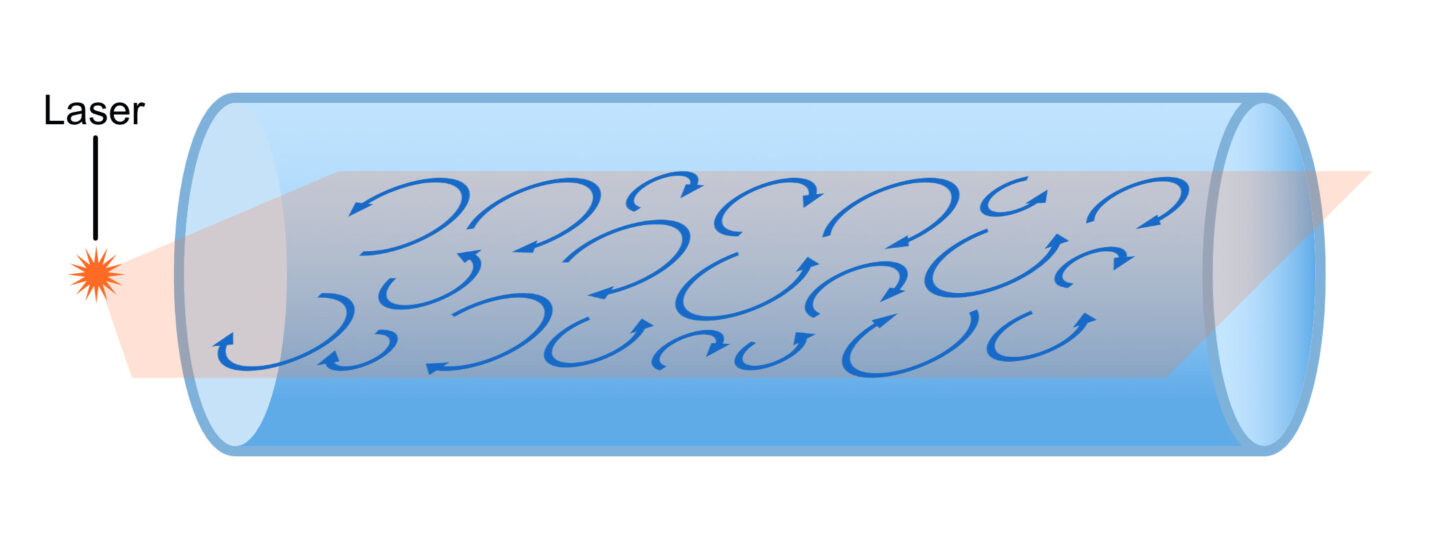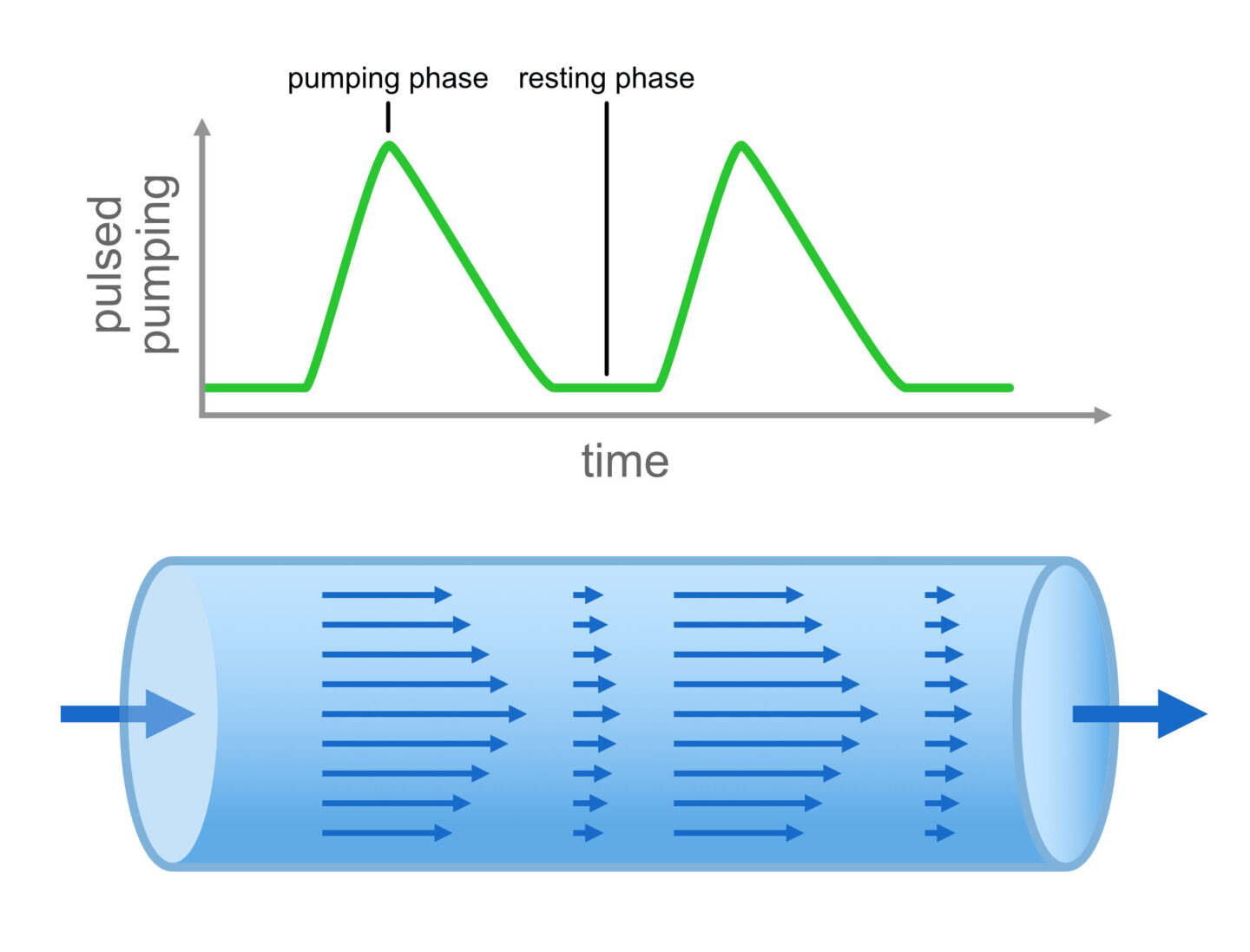September 6, 2023
Pumping like the Heart
ISTA scientists show how pulsating pumping can lead to energy savings
Pumping liquids may seem like a solved problem but optimizing the process is still an area of active research. Any pumping application—from industrial scales to heating systems at home—would benefit from a reduction in energy demands. Researchers at the Institute of Science and Technology Austria now showed how pulsed pumping can reduce both friction from and energy consumption of pumping. For this, they took inspiration from a pumping system intimately familiar to everyone: the human heart.
According to an international study, nearly twenty percent of global electric power are used for pumping liquids around—ranging from industrial applications pumping oil and gas to heating installations pumping hot water in private homes. A team of researchers around Davide Scarselli and Björn Hof from the Institute of Science and Technology Austria (ISTA) looked for a way to reduce these energy demands, taking inspiration from nature. In a new study, now published in the scientific journal Nature, they showed that pumping liquids through a pipe in pulses—much like the human heart pumps blood—can reduce the friction in the pipe and therefore also the energy consumed.
Turbulent friction
“Over the years, researchers and engineers have been trying to make pumping fluids more efficient,” Davide Scarselli, first author of the study, says. “While many solutions are being simulated or tested in labs, they often are too complex and therefore too costly to be implemented in real industrial applications. We were looking for an approach that does not require complicated structural changes to the infrastructure like sensors and actuators.”
Instead of changing the makeup of the pipes to reduce the friction between the moving liquid and the pipes’ walls, the scientists tried a different approach. “Like any part of our bodies, the human heart has been shaped by millions of years of evolution,” Björn Hof, professor at ISTA, explains. “Unlike common mechanical pumps, which create a steady stream of liquid, the heart pulsates. We were curious if there may be an advantage to this peculiar propulsion form.”
To this end, Scarselli and his colleague Atul Varshney created several experimental setups using clear pipes with different lengths and diameters through which they pumped water. “The baseline for our experiments was a steady flow of water, where swirls and eddies moved chaotically while being pushed through the pipe,” Scarselli recounts. These swirls and eddies are called turbulence and they create a lot of the friction between the liquid and the walls of the pipe, costing energy to overcome.
The researchers made the turbulence visible by adding tiny reflective particles to the water and shining a laser through the clear pipe. Scarselli adds, “The laser shoots light through the pipe in a horizontal sheet and gets reflected by the particles. We then took pictures that could be used to detect whether the flow was turbulent or laminar—the latter meaning without swirls and eddies.”

Reducing friction by resting
Next, the scientists tried several modes of pulsating pumping. Some pulse modes would first accelerate the water slowly and then quickly stop it, while others would do it the other way around. Hof explains the results, “Typically pulsation increased the drag and the energy required for pumping, which was not what we were looking for. However, when we introduced a short resting phase between the pulses where the pump does not push the water—just like the human heart does—we got much better results.”

With these resting phases between the pumping pulses, the amount of turbulence in the pipe drastically decreased. “During the rest phase, turbulence levels are reduced and make the subsequent acceleration phase much more effective at reducing friction,” Scarselli adds.
For an optimized pulsing pumping motion similar to the one of the human heart, the researchers found a 27 percent decrease of mean friction and a 9 percent reduction in energy demand. “A reduction of friction and turbulent fluctuations is clearly advantageous in the biological context because it prevents damage to the cells sensitive to shear stress that make up the inner most layer of our blood vessels. We could potentially learn from this and exploit it in future applications,” Hof explains.
Scarselli adds, “While we demonstrated promising results in the lab, real-world applications of our research are less straight forward. Pumps would have to be refitted to produce these pulsating motions. However, this would still be much less costly than modifications to the pipe walls or fitting of actuators. We hope that other scientists will build upon our results to explore these nature-inspired solutions for industrial applications.”

Personalia:
Davide Scarselli grew up in Bergamo, Italy, and did his Master’s in aeronautical engineering in Milan. In 2015, he moved to Austria to join Björn Hof’s research group, first as an intern, then as a PhD student, and finally as a postdoc. He now works as an automation and data engineer at a company in Linz, Austria.
Björn Hof grew up in Marburg, Germany. After obtaining his PhD from the University of Manchester, UK, in 2001, he carried out postdocs in Manchester and at the Delft University of Technology. From 2007 to 2013, he led a research group at the Max Planck Institute for Dynamics and Self-Organization in Göttingen, Germany. He then started his position as a professor at ISTA. His group seeks to gain insight into the nature of turbulence and the dynamics of complex fluids.
Publication:
D. Scarselli, J. M. Lopez, A. Varshney, and B. Hof. 2023. Turbulence suppression by cardiac cycle inspired pulsatile driving of pipe flow. Nature. DOI: 10.1038/s41586-023-06399-5
Funding information:
The work was supported by the grant 662962 of the Simons foundation and by the Austrian Science Fund, grant I4188-N30, within the Deutsche Forschungsgemeinschaft research unit FOR 2688.



